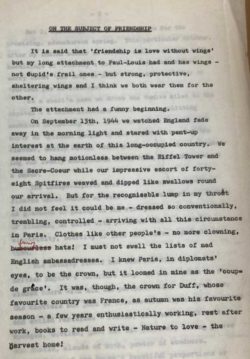Many of the sources scholars use for their research can be categorised as life writing. Broadly, life writing encompasses any source where someone reflects on their life. It could be their own, it could be that of a family member, friend or research subject.
Life writing takes many forms, from autobiographies, diaries, and letters to more unusual sources such as photo albums, scrapbooks, comics, or blogs.
Here at Churchill Archives Centre, thousands of life writing sources live on our shelves, awaiting their reader. This research guide, published over the course of a week, showcases the variety of material we have in our collections. This is by no means exhaustive, but a menu of life writing ready for your delectation and delight. Today, we start with autobiographies.
Autobiographies
Autobiographies are one of the most common forms of life writing, where individuals reflect on their lives in their own words. Sometimes people might write an autobiography on their whole life; others will just write on a specific episode which they deem important.
Lady Diana Cooper (1892-1986), aristocrat and socialite, published several autobiographies, documenting her experiences leading the society group ‘The Coterie’, working as a nurse during the First World War, embarking on a brief theatrical career, and supporting the work of her husband and ambassador Alfred Duff Cooper, 1st Viscount Norwich of Aldwick.
Churchill Archives holds Lady Diana’s literary papers, including those relating to her published autobiography. We also preserve a few shorter documents where Lady Diana writes on a specific topic of interest to her.
One of these topics is her friendship with French industrialist Commandant Paul-Louis Weiller, which started when she moved to France with Duff in 1944, when he became Ambassador to France.
When Lady Diana moved to France, she initially reflected on how she:
“was as green as a cabbage and knew really no French people at all. In those very early days after the liberation of Paris, there was constant whispering of the fearful word ‘collabo’”.
She met Weiller when he came to use the piano in their house. Reminiscing on the friendship years later, Cooper writes
“It is said that ‘friendship is love without wings’ but my long attachment to Paul-Louis had and has wings – not Cupid’s frail ones – but strong, protective, sheltering wings and I think we both wear them for the other.”
Find out more about:
- Lady Diana’s and her husband Duff Cooper’s respective diaries at the Archives Centre, or read a published version of Duff Cooper’s diaries edited and introduced by his son John Julius Norwich.
- Working with autobiographies, by reading James Olney’s Autobiography: Essays Theoretical and Critical and Sidonie Smith and Julia Watson’s Women, Autobiography, Theory: A Reader.
Other autobiographies and memoirs within our collections:
- Clement Attlee’s autobiography, 1883-1955, GBR/0014/ATLE 1. The drafts for the autobiography were begun at least as early as 1951 when Attlee left office. Quite a lot of the material was not used, partly because it was not strictly relevant to the theme of the book and partly to avoid embarrassment to people still living. In addition the contents of the early chapters were re-arranged so that paragraphs appear in a slightly different context. The draft is not complete and in this catalogue the dates and chapter headings refer to the draft rather than the printed book.
- Captain Arthur Clarke autobiography, Contented Sailor, 1898-1974, AWCL 2. This collection includes the official and private log books he compiled during the period while he was a midshipman, with fine plans and sketches, perhaps the most interesting of which are those relating to the Dardanelles campaign. The collection also contains a number of photograph albums showing the life of these very young officers – Clarke and his contemporaries – during this period. The collection is completed with Captain Clarke’s two-volume biography which describes, as well as his World War I experiences, the next forty years of a full and varied career which took him all round the world and ended with nine years as Chief of Naval Information.
- Dame Enid Russell-Smith’s draft memoir, 1925-1963, RUSM 2/1. Comprising two drafts of 53 pages, with manuscript annotations.
- Sarah Churchill drafts of autobiography Keep on Dancing, 1981, SCHL 3/5/2. Comprising annotated typescript drafts and notes from press cuttings, covering the years 1940-60.
- Margaret Thatcher’s memoir of the Falkland’s conflict, 1983, THCR 1/20/3/1. Over Easter 1983, working alone at Chequers, Thatcher wrote this 128 page recollection of the Falklands War. See it in our Reading Room or view it online here.
- Sir Antony Part’s papers concerning The making of a mandarin, 1986-89, PART 1. Papers concerning the compilation and publication of Part’s autobiography, The making of a mandarin; with other papers including speeches given before and after Part’s civil service career and business papers after his retirement.

An extract from Lady Diana Cooper’s autobiographical material titled ’On the Subject of Friendship’. Source: GBR/0014/DIAC 3/12.
If we’ve whetted your appetite, then do get in touch to explore our collections.
Looking for useful introductions for working with life writing? Here’s some of our favourites:
- Dobson, Miriam, and Benjamin Ziemann, eds. Reading primary sources: the interpretation of texts from nineteenth and twentieth century history. Routledge, 2020.
- Barber, Sarah, and Corinna Peniston-Bird, eds. History beyond the text: a student’s guide to approaching alternative sources. Routledge, 2013.
- Summerfield, Penny. Histories of the self: Personal narratives and historical practice. Routledge, 2018.
- Saunders, Valerie, “Life Writing”. In Victorian Literature, (accessed 4 Aug. 2021).
By Cherish Watton, Archives Assistant.
Subscribe to Churchill Archives Centre News
Enter your email address:
Subscribe to the Churchill Archives News RSS feed:
